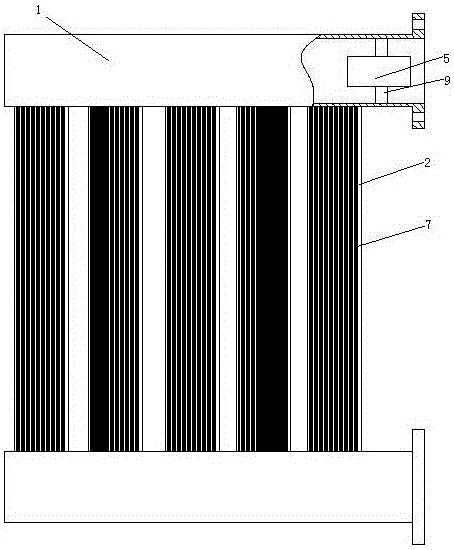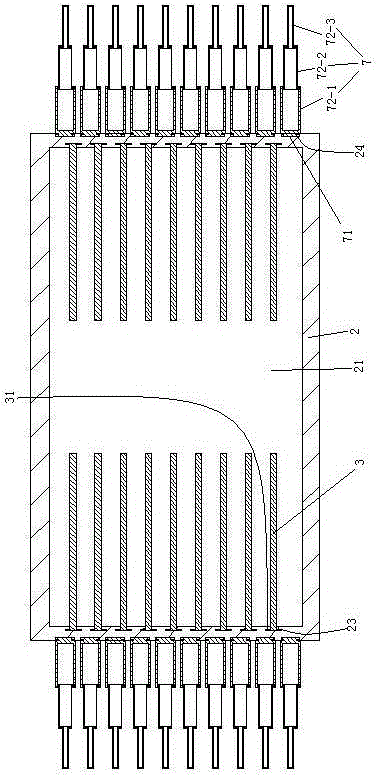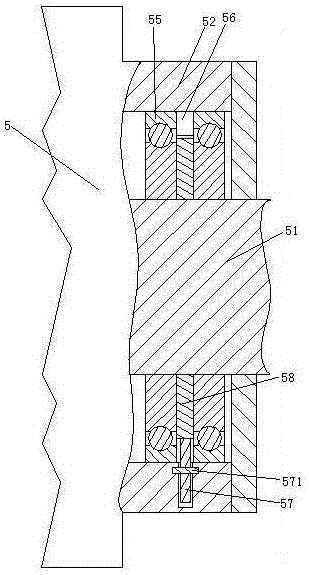Transformer radiator with detachable connection of inner fins and telescopic outer fins
A technology for dismantling connections and outer fins, applied in transformer/inductor cooling, laminated components, heat exchange equipment, etc., can solve the problem of poor heat dissipation of transformer radiators, achieve good shock isolation effect, and adjustable heat dissipation , good cooling effect
- Summary
- Abstract
- Description
- Claims
- Application Information
AI Technical Summary
Problems solved by technology
Method used
Image
Examples
Embodiment 1
[0035] Example 1, see figure 1 , A transformer radiator with inner fins and telescopic outer fins detachably connected, comprising two oil pipes 1 and a plurality of radiating fins 2 connected between the two oil pipes. The two oil pipes 1 are distributed up and down and extend horizontally. A circulating pump 5 is provided in the upper oil pipe of the oil pipe 1. The circulating pump 5 is suspended in the oil pipe 1 through four shock isolation blocks 9. A number of outer fins 7 are provided outside the heat sink 2.
[0036] See figure 2 , The heat sink 2 is provided with a flow channel 21. Runner 21 connects two oil pipes 1 (see figure 1 ) Connected. A number of inner fins 3 and inner grooves 23 are provided in the flow channel 21. The inner fin 3 is provided with an inner fin portion chuck 31. The inner fin 3 is inserted into the inner groove 23 and connected to the heat sink 2 through the inner fin portion clamp 31. The inner fin part clamping head 31 is pluggably inse...
Embodiment 2
[0048] The second embodiment is different from the first embodiment:
[0049] See Picture 10 , A circular inner rod 511 is penetrated in the pump shaft 51. The inner rod 511 has a tubular structure. The inner surface of the pump shaft 51 is provided with an inner friction layer 512. The inner rod 511 includes a left rod 5111 and a right rod 5112. The outer peripheral surfaces of the left rod 5111 and the right rod 5112 are both provided with an outer friction layer 5113. The outer friction layer 5113 covers the inner rod 511 along the circumferential direction of the inner rod 511. The left end of the left rod 5111 is connected to the pump shaft 51 through a left energy absorbing spring 513. The right end surface of the left rod 5111 is provided with a plurality of first reversing teeth 5114 distributed along the circumferential direction of the left rod. The right end of the right rod 5112 is connected to the pump shaft 51 through a right energy absorbing spring 514. The ...
Embodiment 3
[0051] The third embodiment is different from the second embodiment:
[0052] See Picture 11 , The heat sink 2 is provided with a number of connecting pipes 22 communicating with the flow channel 21. The oil pipe 1 is provided with a number of oil holes 11. A pipe socket 12 is connected to the outer end of the oil hole 11. The base 12 and the oil pipe 1 are welded together. An inner tube 4 is penetrated in the oil hole 11. The inner end of the inner tube 4 is provided with a flange 41. The inner pipe 4 passes through the pipe socket 12 and then penetrates into the connecting pipe 22 one by one to realize the communication between the oil pipe 1 and the flow passage 21 in the heat sink 2.
[0053] See Picture 12 , The flange 41 is hooked on the inner peripheral surface of the oil pipe 1. The flange 41 and the inner peripheral surface of the oil pipe 1 are connected together only by abutment. The junctions of the socket 12, the inner tube 4 and the connecting tube 22 are weld...
PUM
 Login to View More
Login to View More Abstract
Description
Claims
Application Information
 Login to View More
Login to View More - R&D
- Intellectual Property
- Life Sciences
- Materials
- Tech Scout
- Unparalleled Data Quality
- Higher Quality Content
- 60% Fewer Hallucinations
Browse by: Latest US Patents, China's latest patents, Technical Efficacy Thesaurus, Application Domain, Technology Topic, Popular Technical Reports.
© 2025 PatSnap. All rights reserved.Legal|Privacy policy|Modern Slavery Act Transparency Statement|Sitemap|About US| Contact US: help@patsnap.com



